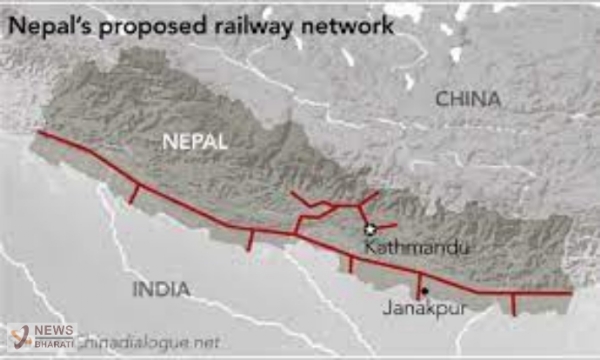The China connection in Nepal’s Connectivity Infrastructure
Pokhara international airport has been built at the cost of US$ 216 million which was given as a soft loan by China’s EXIM bank in 2016.
Total Views |
Nepal’s Pokhara airport has been in the news for the past few days due to a deadly plane crash of ATR-72 aircraft, run by Yeti Airlines. The flight took off from Kathmandu airport on the morning of 15th January and crashed due to unidentified reasons just before landing at Pokhara airport. It has led to the death of nearly all 72 people on board including crew members and thus, it is being considered as Nepal’s deadliest accidents in the past 30 years. Apart from this tragic accident, Pokhara airport has also been in the news as this new airport was inaugurated on 1st January by Nepal’s PM Pushpa Kamal Dahal. It is specifically important for India since this airport was built with Chinese assistance and thus, increases China’s presence in India’s immediate neighbourhood.

The case of Pokhara airport
Pokhara international airport has been built at the cost of US$ 216 million which was given as a soft loan by China’s EXIM bank in 2016. The construction for this project was started by China CAMC Engineering Company Limited in 2017. The project was signed earlier in 2016 when Nepal was not a part of China’s Belt and Road Initiative project. Hence, when the Chinese embassy in Nepal announced on Twitter a day before the inauguration that Pokhara airport is “the flagship project of China-Nepal BRI cooperation”, it created a huge discontent among Nepali officials. As per these officials, Nepal became a member of BRI in 2017 which is a year after signing of airport contract. Further, talks for this contract began in 2008, much before BRI was even conceptualized by Chinese President Xi Jinping in 2013. Moreover, the loan agreement between China’s EXIM bank and Nepal’s civil aviation authority does not have any mention of BRI. Even Nepal’s former foreign minister Prakash Mahat who signed the BRI agreement in 2017 has cleared that Pokhara airport does not fall under BRI. Analysts in Nepal and other scholars suggest that China has been promoting every project as a BRI project where Chinese finances are involved. Moreover, there is no clear distinction between BRI and non-BRI projects from the Chinese side. Especially in Nepal, it is important for China to project that BRI is running smoothly. Thus, whatever is written in signed documents should be considered true and the Chinese side should respect agreements in ‘letter and spirit’ to avoid any confusion. Tagging projects under BRI would not change modalities of projects, but instead may backfire for Chinese considering negative perceptions about BRI globally. Further, it is being estimated that if not managed well, this airport may become another ‘white elephant’ under BRI and would further damage prospects of China’s ambitious initiative.
Status of BRI in Nepal
China’s ambitious BRI project has connected China to far-off regions like Africa, South America as well as Europe. However, China has failed to implement a single BRI project in its immediate neighbour - Nepal. Surprisingly, Nepal joined BRI in 2017 – five years after the launch of BRI. At that time, both countries had listed 35 projects to be supported by the BRI mechanism. However, as negotiations went forward, the list was brought down to only nine projects which did not include Pokhara airport. China’s investments in Nepal have exhibited three patterns: First type includes involvement of Chinese workers only. For instance, Gautama Buddha airport at Lumbini which is funded by the Asian Development Bank and implemented by Chinese workers. Second type finances are arranged by the Nepal government and implementation is managed by Chinese companies such as in the case of the upgradation of Kathmandu airport. The third type is seen in Pokhara airport where both finances and execution is managed by Chinese enterprises. Nepal’s weak economic conditions is one of the most significant reasons for the slow progress of BRI in Nepal. Due to the small size of the economy, the Nepal government has preferred to accept grants instead of loans from Chinese banks. Further, Nepal has also put conditionalities on loan structuring such as less than one per cent interest rates with repayment period extending over 40 years. These conditions are not easily acceptable by China as it would put more burden on China’s banking system which is already facing a crisis. Thus, both countries have failed to reach a consensus to streamline delayed BRI projects. These issues are expected to be resolved soon as new PM Pushpa Kamal Dahal is widely considered as leaned towards China as opposed to his predecessors. Despite this, China has been consistently investing in Nepal’s projects and has been challenging India’s long-term presence in Nepal.
Also Read: China’s New Arabian Diplomacy
Implications for India
China and Nepal have currently agreed to go ahead with two projects under BRI. One of them is a cross-border railway line that will connect Kathmandu to Kerung in Tibet. The feasibility study for this project has already begun in 2022 as soon as Dahal became the PM. The total project is expected to cost over two billion due to difficult geographical terrain. This rail line will further connect to Lhasa and thus, stimulate development on the China-Nepal border in Tibet. However, for a small country like Nepal with just over US$ 30 billion GDP, this project would be financially burdensome. Moreover, the current feasibility study in Nepal is sponsored by Chinese grants which can allow China to push Nepal to go ahead with this project. However, Nepal has to carefully assess if benefits from this project for themselves outweigh economic and environmental costs. Experts suggest that this project would help China more to facilitate its trade with India via Nepal rather than strengthening its trade relations with Nepal. Hence, it is necessary for Nepal to carefully assess this project to avoid being dragged into India-China frictions.
Second project approved under BRI is a cross-border electricity transmission line from Ratmate to Kerung. Even though progress of this project was halted due to pandemic, this project can have significant implications for India. Currently, India is the only external consumer of Nepal’s excess electricity generated from its hydropower stations. However, this may change if the Ratmate-Kerung transmission line is launched as Nepal would get an alternate partner for their exports. Thus, this project may affect dynamics of India-Nepal relations to some extent. Further, both these projects are being planned through geographically fragile areas in Eastern Nepal and thus, scientific environmental assessment would be necessary to avoid any harmful impact from this project. Moreover, Nepal plans to supply electricity to Bangladesh and Sri Lanka through India. This may help integration of a major part of South Asia. However, India has opposed this project as electricity used for this project will be generated from Tamakoshi hydropower project which was built with Chinese assistance. Such a stance may damage India’s position in the neighbourhood and strengthen the ‘big brother syndrome’ of neighbouring countries about India. Thus, India needs to consider allowing Nepal’s surplus electricity to be exported to other South Asian countries without any conditionalities so as to avoid another neighbour being pushed towards China.


